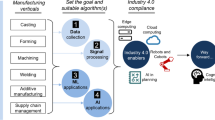Abstract
Automated generation of all feasible assembly sequences for a given product is highly desirable in manufacturing industry. Many researches in the past decades described efforts to find more efficient algorithms for assembly sequence planning. By combining bacterial chemotaxis (BC) with genetic algorithm (GA), a novel BC-GA-based hybrid algorithm (BGHA) for assembly sequence planning is proposed in this paper. Each assembly sequence is encoded into a chromosome, which can be manipulated by genetic operators. Each gene in chromosome is treated as a bacterium, which affects properties of genetic operators by various moving behavior. By injecting BC into the properties of genetic operators, it can keep diversity of the populations during evolution process. The proposed algorithm is tested and compared with GA and Fuzzy logic-GA. Results show that BGHA can upgrade the quality in solution searching and decrease the probability of trapping into local optimal solutions.
Similar content being viewed by others
References
Lai HY, Huang CT (2004) A systematic approach for automatic assembly sequence plan generation. Int J Adv Manuf Technol 24(9–10):752–763
Smith SSF, Smith GC, Liao XY (2001) Automatic stable assembly sequence generation and evaluation. J Manuf Syst 20(4):225–235
Baldwin D, Abell TE, Lui MC, De Fazio TL, Whitney DE (1991) An integrated computer aid for generating and evaluating assembly sequences for mechanical products. IEEE T Robotic Autom 7(1):78–94
Su Q (2009) A hierarchical approach on assembly sequence planning and optimal sequences analyzing. Robot Cim-Int Manuf 25(1):224–234
Homem de Mello LS, Sanderson AC (1991) A correct and complete algorithm for the generation of mechanical assembly sequences. IEEE T Robotic Autom 7(2):228–240
De Fazio TL, Whitney DE (1987) Simplified generation of all mechanical assembly sequences. IEEE J Robotics Autom 3(6):640–658
Gottipolu RB, Ghosh K (1997) Representation and selection of assembly sequences in computer-aided assembly process planning. Int J Prod Res 35(12):3447–3465
Laperrière L, Elmaraghy HA (1996) GAPP: a generative assembly process planner. J Manuf Syst 15(4):282–293
Chang CC, Tseng HE, Meng LP (2009) Artificial immune systems for assembly sequence planning exploration. Eng Appl Artif Intel 22(8):1218–1232
Dong TY, Tong RF, Zhang L, Dong JX (2007) A knowledge-based approach to assembly sequence planning. Int J Adv Manuf Technol 32(11–12):1232–1244
Zha XF, Samuel YEL, Fok SC (1998) Integrated knowledge-based assembly sequence planning. Int J Adv Manuf Technol 14(1):50–64
Lazzerini B, Marcelloni F (2000) A genetic algorithm for generating optimal assembly plans. Artif Intell Eng 14(4):319–329
Chen SF, Liu Y (2001) An adaptive genetic assembly sequence planner. Int J Comp Integ M 14(5):489–500
Smith GC, Smith SSF (2003) Automated initial population generation for genetic assembly planning. Int J Comp Integ M 16(3):219–228
Senin N, Groppetti R, Wallace DR (2000) Concurrent assembly planning with genetic algorithms. Robot Cim-Int Manuf 16(4):65–72
Chen SF (1998) Assembly planning-a genetic approach. Proceedings of the 24th ASME Design Automation Conference, Atlanta,Georgia, 12-16 September Paper no. DETC98/DAC5798
Chen SF, Liu Y(2001) The application of multi-level genetic algorithms in assembly planning. J Ind Technol 17(4) [online serial]. Available: http://www.nait.org
Smith SSF (2004) Using multiple genetic operators to reduce premature convergence in genetic assembly planning. Comput Ind 54(1):35–49
Hong DS, Cho HS (1995) A neural network-based computational scheme for generating optimized robotic assembly sequence. Eng Appl Artif Intel 8(2):129–145
Chen WC, Tai PH, Deng WJ, Hsieh LF (2008) A three-stage integrated approach for assembly sequence planning using neural networks. Expert Syst Appl 34(3):1777–1786
Hong DS, Cho HS (1999) Generation of robotic assembly sequences using a simulated annealing. Proceedings of the IEEE/RSJ international conference on intelligent robots and systems, Kyongju, Korea 2(2):1247-1252
Motavalli S, Islam AU (1997) Multi-criteria assembly sequence. Comput Ind Eng 32(4):743–751
Hong DS, Cho HS (1997) Generation of robotic assembly sequences with consideration of line balancing using simulated annealing. Robotica 15(6):663–673
Failli F, Dini G (2000) Ant colony systems in assembly planning: a new approach to sequence detection and optimization. Proceedings of the 2nd CIRP international seminar on intelligent computation in manufacturing engineering, Capri, Italy, 227-232
Wang JF, Liu JH, Zhong YF (2005) A novel ant colony algorithm to assembly sequence planning. Int J Adv Manuf Technol 25(11–12):1137–1143
Cao PB, Xiao RB (2007) Assembly planning using a novel immune approach. Int J Adv Manuf Technol 31(7–8):770–782
Wang Y, Liu JH (2009) Chaotic particle swarm optimization for assembly sequence planning. Robot Cim-Int Manuf 26(2):212–222
Gao L, Qian WR, Li XY, Wang JF (2010) Application of memetic algorithm in assembly sequence planning. Int J Adv Manuf Technol doi:10.1007/s00170-009-2449-1
Berg HC, Brown DA (1972) Chemotaxis in Escherichia coli analyzed by three-dimensional tracking. Nature 2399(5374):500–504
Müller SD, Marchetto J, Airaghi S, Koumoutsakos P (2002) Optimization based on bacterial chemotaxis. IEEE T Evolut Comput 6(1):16–29
Huang W, Zhang C, Yang JY, Zhang JH ,Liu, ZF , Wei ZL, Pan DL (2008) Using bacterial chemotaxis method for reactive power optimization. IEEE/PES Transmission and Distribution Conference and Exposition. 1-3, April: Chicago, pp 71-77
Zhang YD, Wu LN (2009) Stock market prediction of S&P 500 via combination of improved BCO approach and BP neural network. Expert Syst Appl 36(5):8849–8854
Dahlquist FW, Elwell RA, Lovely PS (1976) Studies of bacterial chemotaxis in defined concentration gradients. A model for chemotaxis toward L-serine. J Supramol Struct 4(3):329–342
Galantucci LM, Percoco G, Spina R (2004) Assembly and disassembly planning by using Fuzzy logic and genetic algorithms. Int J Adv Robotic Syst 1(2):67–74
Dini G, Santochi M (1992) Automated sequencing and subassembly detection in assembly planning. Annals of the CIRP 41(1):1–4
Author information
Authors and Affiliations
Corresponding author
Rights and permissions
About this article
Cite this article
Zhou, W., Zheng, Jr., Yan, Jj. et al. A novel hybrid algorithm for assembly sequence planning combining bacterial chemotaxis with genetic algorithm. Int J Adv Manuf Technol 52, 715–724 (2011). https://doi.org/10.1007/s00170-010-2738-8
Received:
Accepted:
Published:
Issue Date:
DOI: https://doi.org/10.1007/s00170-010-2738-8




